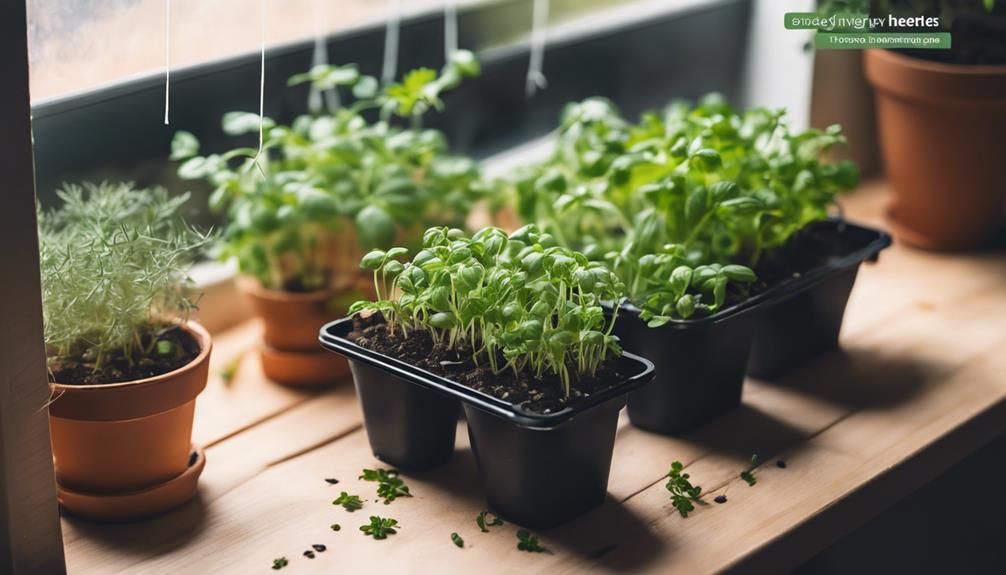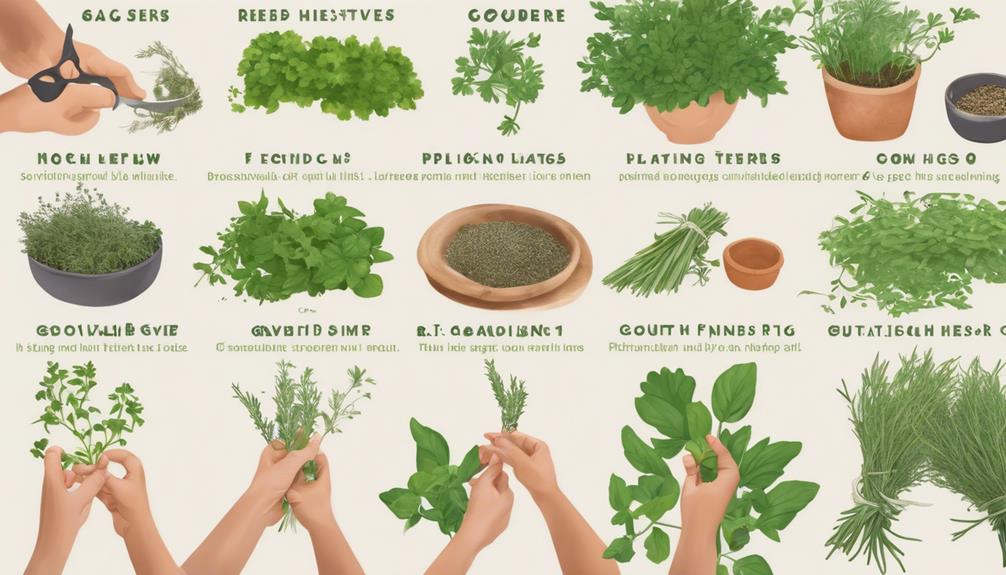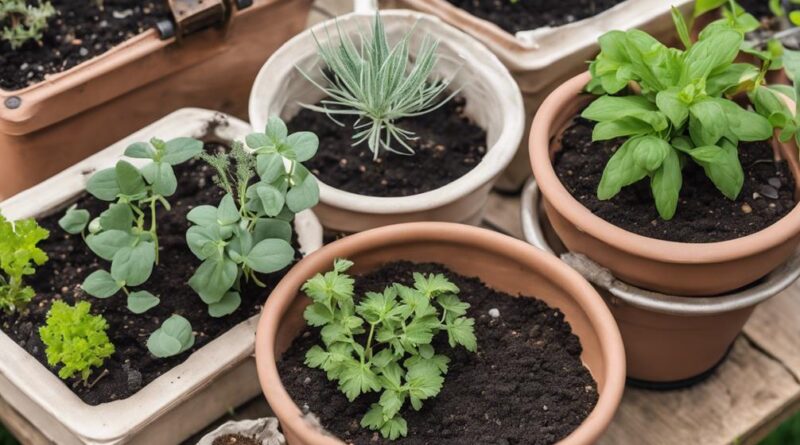10 Tips: Growing Herbs From Seeds Versus Plants
This post may contain affiliate links which means I may receive a commission for purchases made through links. As an Amazon Associate, I earn from qualifying purchases. Learn more on my Private Policy page.
When growing herbs, starting from seeds allows you to understand plant cycles deeply. Provide moisture, warmth, and light for seedlings' care. Proper propagation techniques ensure healthy growth. Observing the transformation from seed to plant enhances knowledge. Buying herb plants is cost-effective and saves time for immediate garden establishment. Consider soil preparation, watering, light exposure, and temperature preferences before starting. Use seedling heat mats for higher germination rates and well-draining soil for seeds. Choose the right plant size based on growth habits. Transplant seedlings carefully. Harvest herbs at ideal times for optimal flavor. Maintain proper care to ensure gardening success.
Benefits of Starting From Seeds
When starting an herb garden, beginning from seeds offers the benefit of fostering a deeper understanding of the plant's life cycle and growth process. Seedling care is crucial in this phase. You must provide adequate moisture, warmth, and light for the seeds to germinate successfully. Once the seedlings emerge, proper propagation techniques are essential to ensure healthy growth. It's fascinating to witness the transformation from a tiny seed to a mature plant, which enhances your knowledge and appreciation of the herb.
Container gardening is a popular choice for growing herbs from seeds. Selecting the right containers is vital for the well-being of your herbs. Ensure the pots have proper drainage to prevent waterlogging, which can lead to root rot. Herb varieties play a significant role in determining the success of your garden. Different herbs have specific requirements regarding sunlight, water, and soil quality. Understanding these variations is essential for the optimal growth of your plants.
Observing the growth of herbs from seeds allows you to witness the entire life cycle firsthand. You can track each stage of development, from germination to flowering. This hands-on experience not only deepens your connection with the plants but also imparts valuable knowledge that can be applied to future gardening endeavors. Starting from seeds is a rewarding journey that enriches your understanding of herbs and their cultivation.
Advantages of Buying Herb Plants
Exploring the option of purchasing herb plants presents distinct advantages in terms of convenience and immediate garden establishment. When considering cost effectiveness, buying herb plants can be more economical than starting from seeds. While seeds require additional resources such as soil, containers, and proper lighting for germination, purchasing established herb plants eliminates these initial costs. Moreover, herb plants are often priced reasonably, especially when factoring in the time and effort saved by skipping the germination and early growth stages.
In addition to cost savings, buying herb plants is a time-saving option. Growing herbs from seeds can be a lengthy process, as seeds need specific conditions to sprout and mature into plants ready for harvesting. By purchasing herb plants, you bypass this waiting period and instantly have mature plants that are ready to be incorporated into your garden or used for culinary purposes. This immediacy not only accelerates the establishment of your herb garden but also provides instant gratification by allowing you to enjoy fresh herbs sooner.
Factors to Consider Before Starting
Before embarking on growing herbs, it's essential to carefully consider several key factors to ensure successful cultivation. Soil preparation is crucial for herb growth. Ensure the soil is well-draining and rich in organic matter to provide essential nutrients. Before planting, test the soil pH to determine if any amendments are necessary for optimal herb growth.
Adequate watering is vital for herb development. Different herbs have varying water needs, so it's important to research individual requirements. Overwatering can lead to root rot, while underwatering can cause wilting and stunted growth.
Light exposure plays a significant role in herb cultivation. Most herbs require full sun to thrive, needing at least 6-8 hours of sunlight daily. Consider the sunlight conditions in your gardening area before choosing herb varieties.
Temperature is another critical factor to consider. Different herbs have different temperature preferences, so ensure you select herbs suitable for your climate. Extreme temperatures can stress herbs and affect their growth and flavor.
Before starting your herb garden, take time to plan and consider these essential factors. By preparing the soil, providing adequate water, ensuring proper light exposure, and considering temperature requirements, you'll set the foundation for successful herb cultivation.
Seed Starting Tips for Beginners
Consider utilizing a seedling heat mat to enhance germination rates when starting herb seeds indoors. Proper soil preparation is crucial for successful seed starting. Choose a high-quality seed starting mix that's well-draining to prevent waterlogging, which can lead to seed rot. Moisten the soil before planting the seeds to ensure good contact between the seeds and the growing medium. When watering, avoid over-saturating the soil; aim for consistently moist but not waterlogged conditions to support seed germination.
Light is essential for seed germination and seedling growth. Place your containers in a location that receives ample sunlight or use grow lights to provide the necessary amount of light. Keep the temperature consistent for optimal germination. Most herb seeds require temperatures between 60-70°F (15-21°C) to sprout successfully. Consider using a thermometer to monitor the temperature and adjust as needed.
Once your herb seeds have germinated, continue to provide them with adequate light and maintain the right temperature. As the seedlings grow, you can gradually introduce them to outdoor conditions to acclimate before transplanting them into your garden. By following these seed starting tips, you can increase the likelihood of successfully growing herbs from seeds and enjoy a bountiful herb garden.
Choosing the Right Plant Size
When selecting the right plant size for your herb garden, it's important to consider the growth habits and space requirements of the specific herbs you intend to cultivate. Container gardening is a popular choice for growing herbs, as it allows for flexibility in managing the sizes of your plants. Some herbs, like basil and parsley, thrive in smaller containers, making them suitable for windowsills or kitchen countertops. These herbs are considered compact growers and can adapt well to limited space. On the other hand, herbs such as rosemary and sage are known to grow larger and require more room to spread their roots. For these herbs, using larger containers or planting them directly in the ground is recommended to accommodate their size.
Understanding planting techniques is crucial when choosing the right plant size. Herbs that have shallow roots, like cilantro and dill, can be planted in shallower containers. However, herbs with deeper root systems, such as thyme and oregano, benefit from deeper pots that allow for proper root development. Ensuring that your herbs have adequate space for root growth is essential for their overall health and longevity. By matching the plant size to the growth habits and space requirements of your herbs, you can create an optimal environment for a thriving herb garden.
Transplanting Seedlings Successfully
To successfully transplant seedlings, ensure the soil is well-drained and the containers have adequate drainage holes. Proper drainage is crucial as it prevents waterlogging, which can lead to root rot and hinder root system development. When transplanting, gently remove the seedling from its current container, being careful not to damage the roots. Prepare the new container by filling it with well-draining soil, leaving enough space for the seedling's root system to spread out. Carefully place the seedling in the center of the new container and fill the remaining space with soil, pressing it lightly to secure the plant in place.
Root system development is essential for the seedling's growth and overall health. To promote healthy root growth, water the transplanted seedling according to a consistent watering schedule. Avoid overwatering, as this can lead to root rot, and ensure the soil is moist but not waterlogged. Additionally, place the container in an area that receives adequate sunlight based on the specific requirements of the herb you're growing. Most herbs require at least 6-8 hours of sunlight per day to thrive.
Best Practices for Seed Germination

For successful seed germination, maintain proper moisture levels and temperature conditions conducive to the specific herb seeds you're planting. Ensuring the right environment is crucial for the seeds to germinate effectively. Here are some best practices to optimize seed germination:
- Consistent Moisture: Keep the growing medium consistently moist but not waterlogged. Dry conditions can hinder germination, while excessive moisture can lead to rot. Regularly check the moisture levels of the soil to provide the ideal growing conditions for the seeds.
- Optimal Temperature: Different herb seeds have specific temperature requirements for germination. Research the ideal temperature range for the herb seeds you're planting and maintain a consistent temperature to promote germination. Using a heat mat or placing the seeds in a warm location can help achieve the optimal temperature.
- Proper Lighting: Once the seeds have germinated, provide them with adequate light. Place the seedlings in a location where they can receive the right amount of sunlight or use grow lights to supplement natural light. Proper lighting is essential for healthy seedling growth and development.
Maintenance Differences: Seeds Vs Plants
Have you ever wondered how the maintenance of herb seeds differs from that of established plants? When it comes to watering frequency, herb seeds require more delicate care. They need to be consistently moist but not waterlogged, which might mean misting them regularly. Established plants have deeper roots and can generally tolerate a bit more variation in watering schedules.
For both seeds and plants, the soil quality is paramount. Seeds need a light, well-draining mix to prevent rot, while established plants benefit from occasional repotting with fresh soil to replenish nutrients.
Pruning techniques also vary between seeds and plants. With seeds, you may need to thin out seedlings to prevent overcrowding and ensure proper growth. Established plants require regular pruning to encourage bushier growth and prevent legginess. Light requirements differ as well; seeds often need indirect light to germinate, while mature plants have specific light preferences depending on the herb variety.
Harvesting and Using Fresh Herbs

When harvesting fresh herbs, timing plays a crucial role in ensuring optimal flavor and potency. To make the most of your herb garden, follow these tips:
- Harvesting Techniques: Each herb has its own ideal harvesting time. For leafy herbs like basil and mint, regularly pinch off the top leaves to encourage bushier growth and prevent flowering, which can diminish the flavor. Woody herbs like rosemary and thyme should be pruned by cutting the stems back to a leaf set to promote new growth.
- Preserving Flavor Profiles: The best time to harvest herbs is in the morning after the dew has dried but before the sun gets too hot. This is when the essential oils that give herbs their flavor are at their peak. To preserve these oils, gently rinse the herbs in cold water and pat them dry with a paper towel before use.
- Using Fresh Herbs: Fresh herbs can elevate any dish. Add delicate herbs like parsley and cilantro at the end of cooking to retain their fresh flavor. Robust herbs like sage and oregano can withstand longer cooking times and are perfect for infusing oils or vinegars. Experiment with different combinations to enhance your culinary creations.
Troubleshooting Common Issues
To address common issues that may arise when growing herbs, it's essential to understand the potential challenges and how to effectively troubleshoot them.
Pest management is a crucial aspect of herb cultivation. Keep an eye out for common pests such as aphids, spider mites, and caterpillars. To manage these pests, you can introduce beneficial insects like ladybugs or use insecticidal soap. Regularly inspect the plants for any signs of pest infestation and take prompt action to prevent damage.
Another common issue to troubleshoot is watering frequency. Overwatering can lead to root rot, while underwatering can cause wilting and stunted growth. The key is to maintain consistent moisture levels in the soil. A good practice is to water herbs when the top inch of soil feels dry to the touch. Adjust the watering frequency based on the specific needs of each herb variety and the environmental conditions.
Frequently Asked Questions
Can I Grow Herbs From Both Seeds and Plants in the Same Garden?
Yes, you can grow herbs from both seeds and plants in the same garden. When incorporating companion planting, consider grouping herbs that benefit each other.
Container gardening allows for easy organization of different herb varieties. Ensure proper spacing and sunlight for optimal growth.
Seeds provide a cost-effective option, while plants offer a head start. Experiment with both methods to find what works best for your garden and enjoy a diverse herb harvest.
Are There Any Specific Herbs That Are Easier to Grow From Seeds?
When it comes to growing herbs from seeds, some varieties are easier to cultivate than others. For instance, basil, cilantro, and dill generally have high germination rates and are relatively simple to care for as seedlings. These herbs also transplant well and have fast growth timelines, making them excellent options for beginners.
Starting with these herbs can help you build confidence and experience in seed starting and herb cultivation.
How Often Should I Water Herb Plants Grown From Seeds?
To determine the watering frequency for herb plants grown from seeds, consider the type of herb, its growth rate, and sunlight exposure. Most herbs prefer well-drained soil, so water when the top inch feels dry. Generally, 1-2 times per week is sufficient, adjusting based on your specific plant's needs.
Monitor for signs of overwatering or underwatering. Adequate sunlight exposure also plays a crucial role in the plant's health, growth rate, and pest resistance.
Do Herb Plants Started From Seeds Require Different Soil Types?
When growing herb plants from seeds, the soil composition plays a crucial role in their germination rate. Different herb species have specific soil requirements to thrive. Ensure the soil is well-draining, loose, and rich in nutrients.
Once the seedlings emerge, provide proper care by watering them regularly and adjusting light exposure. When transplanting, be gentle to avoid damaging the roots. Select a suitable spot with the right soil type for successful growth.
Can I Use the Same Fertilizers for Both Seeds and Herb Plants?
You can use the same fertilizers for both seeds and herb plants, but it's crucial to adjust the application.
When fertilizing seeds, choose a gentle, balanced fertilizer and apply sparingly to avoid overwhelming delicate seedlings. Once transplanted, gradually increase the fertilizer concentration and frequency to support the growing herb plants.
Opt for a slow-release fertilizer to provide sustained nutrients for healthy plant development. Remember, proper fertilization is key to successful herb growth.
Conclusion
In conclusion, whether you choose to grow herbs from seeds or plants, both methods have their own advantages and considerations.
Starting from seeds allows for a more cost-effective and hands-on experience, while buying plants provides a head start in the growing process.
By following the tips and best practices outlined in this article, you can successfully cultivate a thriving herb garden and enjoy the benefits of fresh herbs in your cooking and daily life.
Happy gardening!
